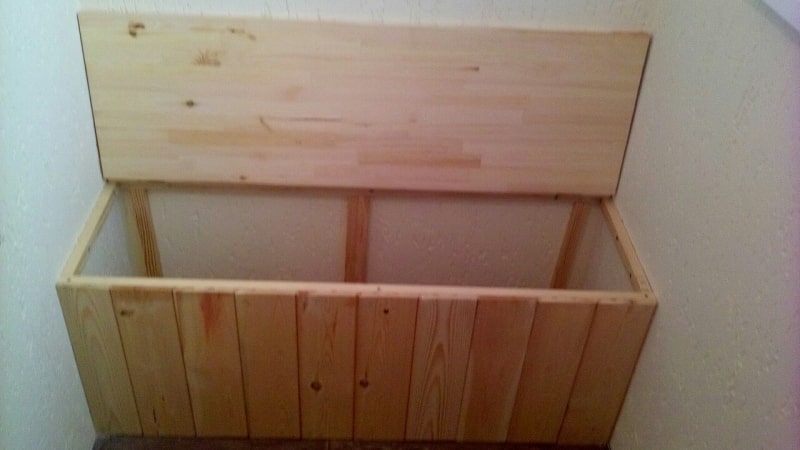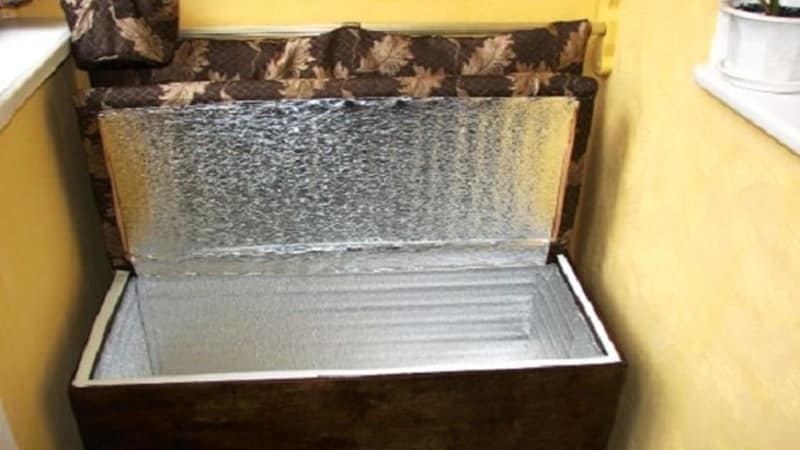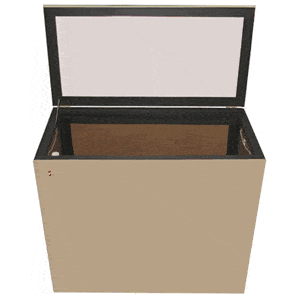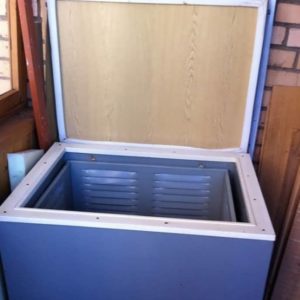Step-by-step instructions: how to insulate a potato storage box on the balcony
Potatoes have become an integral part of the diet of many people. In winter, the vegetable becomes more expensive, and it becomes important to create a design that allows you to keep it fresh until spring. An excellent replacement for a cellar in the city is a balcony or loggia, on which you can install a homemade vegetable storage box in the form of a box.
We'll tell you in this article how to insulate a potato box on the balcony.
Features of storing potatoes in a box on the balcony
Any place intended for vegetable storage, special conditions must be observed under which they will not deteriorate for a long time.
Temperature
Optimal temperature for storing potatoes – +4°С. Deviations of 1-2°C are acceptable. If it gets too warm (above +6°C), the tubers will begin to wither and dry out or the sleeping buds will wake up and the potatoes will begin to grow.
Sub-zero temperatures for storing vegetables are unacceptable. At –2°C, potatoes freeze slightly, become watery and unsuitable for food.
Air humidity
Air in the room where it is stored potato, should be dry, within 40-45%. A hygrometer is used to check room humidity. If humidity is higher than permissible values, the risk of fungal and bacterial infections increases.
Illumination
Any light is undesirable. When exposed to light from artificial sources, the tubers begin to turn green - such potatoes can no longer be eaten.The green color of the tubers is due to the accumulation of chlorophyll associated with solanine under the skin. This compound is toxic; the vegetable turns from edible to poisonous.
Air exchange
A well-thought-out ventilation system will ensure drying and proper cooling of the tubers and preserve the potatoes for 8-10 months.
Without access to air and its free circulation, temperature and humidity increase. This leads to premature aging of the vegetable, loss of taste, change in chemical composition and loss of nutritional properties.
What types of boxes are there?
When choosing a suitable design for storing potatoes, they start from the conditions of the balcony: air temperature, type of double-glazed window (single glass, double, triple), drafts.
Before you start making a container for potatoes, determine the place where exactly the vegetable will be stored on the balcony, and the material from which the box will be made. The best breathable and affordable material is wood.

Heated
This type is suitable for a cold loggia (glazed with single glass). The box is equipped with electric heating. In order to save money, you can opt for a budget version and, instead of a flexible ribbon heating element, use products that are always at hand - a regular hair dryer or incandescent lamps.
Two lamps are placed in a tin cylinder, having previously been painted with dark paint. Incandescent lamps do not consume much electricity, unlike a noisy hair dryer.
Without heating
On a warm balcony, heating the box is not needed. It is enough to cover its walls with insulation. The manufacturing process of such a design is simple and does not require large investments:
- Two rectangular containers are made from timber and slats so that one can fit into the other. The gap between the walls should be 8 cm. The bottom of the boxes is made of moisture-resistant plywood 8-10 mm thick.
- The surface of the products is coated with an antifungal composition for wood (“Snezh” or “Snezh Bio”).
- The space between the walls is filled with insulation - penoplex, sawdust, polystyrene foam or old batting. Experienced builders have recognized penoplex as the best insulation material. It does not absorb moisture at all and is reliably will protect potatoes from the cold.
Other
In addition to the usual homemade box, there are alternative solutions that you can use.
Refrigerated storage chamber
An old, used refrigerator is suitable as a winter cabinet for potatoes.. It is freed from the refrigeration equipment (compressor and heat exchanger) and placed in a horizontal position with the door up.
The manufacturer provides sealed and warm walls in the refrigerator compartment. In them, between the plastic casing and the metal body, the entire space is filled with thermal insulation.
The only thing that remains is to tidy up the appearance: paint it, cover it with plastic panels or beautiful thick fabric. This storage chest can be unheated or heated.
Factory thermobox

The factory thermobox is a metal box in which heating elements are installed that can maintain a temperature of +2...+10°C.
The heating cabinet remains operational when the temperature drops to -35…-40°C. Some models have a manual temperature control system.
Flexible containers
Made of two-layer dense fabric, between the layers of which flexible heating elements are mounted.The maximum capacity of the “miracle bag” is 300 liters.
A soft thermal container is an economical solution for an unheated balcony.
How to insulate a potato box
Before starting to make the box and insulate it, measure the area of the balcony. When planning the dimensions of a potato thermobox, take into account that the depth of the box should not exceed 0.7 m.
Step by step guide
For work you will need the following materials:
- timber with a section of 5×5 cm;
- plywood 15-20 mm thick;
- thermal insulation material 5 mm thick;
- 2-3 incandescent lamps or one 100 W;
- iron pipe;
- screws and iron corners.
How to make an insulated box:
- Determine the dimensions of the thermal container. It will consist of two boxes, one inside the other. The internal base should be 120-140 mm smaller than the external one.
- Cut out 4 future walls of the box and the bottom from plywood. Measure and saw off 4 bars that serve as frame posts. To use as a sheathing for the plywood, saw off 12 bars. Place them horizontally on the product, 2 on each surface, including the lid and floor.
- To protect wood from fungus, treat all workpieces with a special compound (“Pinotex”, “Snezh”). If the box will not be covered in the future with any finishing material, cover all the wood with waterproof varnish or oil paint.
- After the wood and plywood have dried, begin assembling the box. Mount the timber frame and fasten it with iron corners. Provide support for the sides by connecting the corners with additional bars.

- Cover the frame with plywood, which is secured with self-tapping screws.
- Drill small holes in each wall for ventilation.
- Line the inside of the box walls with penoplex. If the balcony is very cold, lay a layer of isolon with foil on top of the penoplex.
- Make an inner drawer using the same principle, changing the dimensions to smaller ones. You can do without a frame by simply covering the walls and floor with plywood.
- In the middle of the box, place an iron pipe on supports (a pipe from a drain will do) with a length slightly less than the length of the box.
- Place electrical equipment in the pipe - lamps with sockets on wires, which are hung on an additional wooden crossbar.
- Mount a temperature sensor on the front wall of the box, which will help control the temperature inside the box. You can design the electrical equipment in such a way that it works automatically. There are thermostats on sale that are equipped with a temperature sensor, which starts heating when the temperature inside the box drops.
The lid for the box is made separately. It is covered with thermal insulation and hung on hinges to the back wall of the heating cabinet.
Reference. If you use a 2 cm thick board instead of plywood, you will not need to make ventilation holes.
Recommendations
To ensure that the thermobox reliably protects the potatoes, follow the recommendations:
- Any thermal box, even a factory-made one, will not save the harvest on an open balcony. A sharp wind, high humidity in autumn and winter, and temperature changes are dangerous not only for potatoes, but also for electrical appliances - they will simply fail. The balcony must be glazed (at least one glass) and slightly insulated (walls and floor).
- Connect the carrying lamp to your home network using an extension cord.
- In very severe frosts, additionally wrap the box with cotton blankets.
Useful tips for storing potatoes on the balcony
It remains to learn some tricks and secrets of preserving the harvest:
- Store only healthy and dry potatoes.
- Regularly inspect and promptly remove rotten and diseased specimens.
- Do not store other vegetables in the same section with potatoes.
Conclusion
An insulated box for storing potatoes on the balcony is easy to make with your own hands. However, if the balcony is used as a living space, a simple box will not look aesthetically pleasing. For additional decoration of the walls, various materials are used: fabric, burlap, oil paint.
If the balcony is decorated in Provence style, the box can be decorated using decoupage technique, and a soft seat with pillows can be built on the lid. This way, the thermobox will not only preserve the tubers until spring, but will also decorate the room.
a sea of water, but no specifics. For example, what thickness of insulation should be based on -25 degrees?